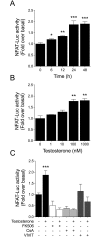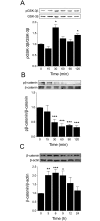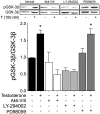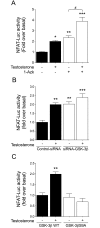GSK-3β/NFAT Signaling Is Involved in Testosterone-Induced Cardiac Myocyte Hypertrophy
- PMID: 27977752
- PMCID: PMC5158037
- DOI: 10.1371/journal.pone.0168255
GSK-3β/NFAT Signaling Is Involved in Testosterone-Induced Cardiac Myocyte Hypertrophy
Abstract
Testosterone induces cardiac hypertrophy through a mechanism that involves a concerted crosstalk between cytosolic and nuclear signaling pathways. Nuclear factor of activated T-cells (NFAT) is associated with the promotion of cardiac hypertrophy, glycogen synthase kinase-3β (GSK-3β) is considered to function as a negative regulator, mainly by modulating NFAT activity. However, the role played by calcineurin-NFAT and GSK-3β signaling in testosterone-induced cardiac hypertrophy has remained unknown. Here, we determined that testosterone stimulates cardiac myocyte hypertrophy through NFAT activation and GSK-3β inhibition. Testosterone increased the activity of NFAT-luciferase (NFAT-Luc) in a time- and dose-dependent manner, with the activity peaking after 24 h of stimulation with 100 nM testosterone. NFAT-Luc activity induced by testosterone was blocked by the calcineurin inhibitors FK506 and cyclosporine A and by 11R-VIVIT, a specific peptide inhibitor of NFAT. Conversely, testosterone inhibited GSK-3β activity as determined by increased GSK-3β phosphorylation at Ser9 and β-catenin protein accumulation, and also by reduction in β-catenin phosphorylation at residues Ser33, Ser37, and Thr41. GSK-3β inhibition with 1-azakenpaullone or a GSK-3β-targeting siRNA increased NFAT-Luc activity, whereas overexpression of a constitutively active GSK-3β mutant (GSK-3βS9A) inhibited NFAT-Luc activation mediated by testosterone. Testosterone-induced cardiac myocyte hypertrophy was established by increased cardiac myocyte size and [3H]-leucine incorporation (as a measurement of cellular protein synthesis). Calcineurin-NFAT inhibition abolished and GSK-3β inhibition promoted the hypertrophy stimulated by testosterone. GSK-3β activation by GSK-3βS9A blocked the increase of hypertrophic markers induced by testosterone. Moreover, inhibition of intracellular androgen receptor prevented testosterone-induced NFAT-Luc activation. Collectively, these results suggest that cardiac myocyte hypertrophy induced by testosterone involves a cooperative mechanism that links androgen signaling with the recruitment of NFAT through calcineurin activation and GSK-3β inhibition.
Conflict of interest statement
The authors have declared that no competing interests exist. I confirm that my commercial affiliation does not alter our adherence to all PLOS policies on sharing data and materials.
Figures







Similar articles
-
Phosphorylation of eukaryotic translation initiation factor 2Bepsilon by glycogen synthase kinase-3beta regulates beta-adrenergic cardiac myocyte hypertrophy.Circ Res. 2004 Apr 16;94(7):926-35. doi: 10.1161/01.RES.0000124977.59827.80. Epub 2004 Mar 4. Circ Res. 2004. PMID: 15001529
-
The AMPK gamma1 R70Q mutant regulates multiple metabolic and growth pathways in neonatal cardiac myocytes.Am J Physiol Heart Circ Physiol. 2007 Dec;293(6):H3456-64. doi: 10.1152/ajpheart.00936.2007. Epub 2007 Sep 28. Am J Physiol Heart Circ Physiol. 2007. PMID: 17906100
-
Inhibition of calcineurin-NFAT hypertrophy signaling by cGMP-dependent protein kinase type I in cardiac myocytes.Proc Natl Acad Sci U S A. 2002 Aug 20;99(17):11363-8. doi: 10.1073/pnas.162100799. Epub 2002 Aug 12. Proc Natl Acad Sci U S A. 2002. PMID: 12177418 Free PMC article.
-
Interference of antihypertrophic molecules and signaling pathways with the Ca2+-calcineurin-NFAT cascade in cardiac myocytes.Cardiovasc Res. 2004 Aug 15;63(3):450-7. doi: 10.1016/j.cardiores.2004.04.002. Cardiovasc Res. 2004. PMID: 15276470 Review.
-
Glycogen synthase kinase-3beta: a novel regulator of cardiac hypertrophy and development.Circ Res. 2002 May 31;90(10):1055-63. doi: 10.1161/01.res.0000018952.70505.f1. Circ Res. 2002. PMID: 12039794 Review.
Cited by
-
Testosterone, cardiomyopathies, and heart failure: a narrative review.Asian J Androl. 2021 Jul-Aug;23(4):348-356. doi: 10.4103/aja.aja_80_20. Asian J Androl. 2021. PMID: 33433530 Free PMC article. Review.
-
Gender Differences in Cardiac Hypertrophy.J Cardiovasc Transl Res. 2020 Feb;13(1):73-84. doi: 10.1007/s12265-019-09907-z. Epub 2019 Aug 15. J Cardiovasc Transl Res. 2020. PMID: 31418109 Review.
-
Testosterone deficiency reduces cardiac hypertrophy in a rat model of severe volume overload.Physiol Rep. 2019 May;7(9):e14088. doi: 10.14814/phy2.14088. Physiol Rep. 2019. PMID: 31054220 Free PMC article.
-
Effect of DHT-Induced Hyperandrogenism on the Pro-Inflammatory Cytokines in a Rat Model of Polycystic Ovary Morphology.Medicina (Kaunas). 2020 Feb 27;56(3):100. doi: 10.3390/medicina56030100. Medicina (Kaunas). 2020. PMID: 32120970 Free PMC article.
-
Genomic and non-genomic effects of androgens in the cardiovascular system: clinical implications.Clin Sci (Lond). 2017 Jul 1;131(13):1405-1418. doi: 10.1042/CS20170090. Clin Sci (Lond). 2017. PMID: 28645930 Free PMC article. Review.
References
-
- Frey N, Katus HA, Olson EN, Hill JA. Hypertrophy of the heart: a new therapeutic target? Circulation. 2004;109(13): 1580–1589. 10.1161/01.CIR.0000120390.68287.BB - DOI - PubMed
-
- Chien KR, Knowlton KU, Zhu H, Chien S. Regulation of cardiac gene expression during myocardial growth and hypertrophy: molecular studies of an adaptive physiologic response. Faseb J. 1991;5(15): 3037–3046. - PubMed
-
- Campbell SE, Farb A, Weber KT. Pathologic remodeling of the myocardium in a weightlifter taking anabolic steroids. Blood pressure. 1993;2(3):213–6. - PubMed
-
- Marsh JD, Lehmann MH, Ritchie RH, Gwathmey JK, Green GE, Schiebinger RJ. Androgen receptors mediate hypertrophy in cardiac myocytes. Circulation. 1998;98(3): 256–261. - PubMed
MeSH terms
Substances
LinkOut - more resources
Full Text Sources
Other Literature Sources
Molecular Biology Databases
Research Materials

